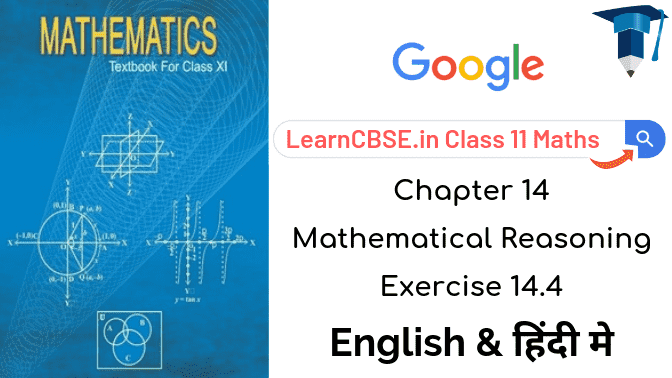Get Free NCERT Solutions for Class 11 Maths Chapter 14 Mathematical Reasoning Ex 14.4 PDF in Hindi and English Medium. Mathematical Reasoning Class 11 Maths NCERT Solutions are extremely helpful while doing your homework. Mathematical Reasoning Ex 14.4 Class 11 Maths NCERT Solutions were prepared by Experienced LearnCBSE.in Teachers. Detailed answers of all the questions in Chapter 14 Class 11 Mathematical Reasoning Ex 14.4 provided in NCERT Textbook.
- Mathematical Reasoning Class 11 Ex 14.1
- Mathematical Reasoning Class 11 Ex 14.2
- Mathematical Reasoning Class 11 Ex 14.3
- Mathematical Reasoning Class 11 Ex 14.4
- Mathematical Reasoning Class 11 Ex 14.5
- Mathematical Reasoning Class 11 Miscellaneous Exercise
- गणितीय विवेचन प्रश्नावली 14.1 का हल हिंदी में
- गणितीय विवेचन प्रश्नावली 14.2 का हल हिंदी में
- गणितीय विवेचन प्रश्नावली 14.3 का हल हिंदी में
- गणितीय विवेचन प्रश्नावली 14.4 का हल हिंदी में
- गणितीय विवेचन प्रश्नावली 14.5 का हल हिंदी में
- गणितीय विवेचन विविध प्रश्नावली का हल हिंदी में
Free download NCERT Solutions for Class 11 Maths Chapter 14 Mathematical Reasoning Ex 14.4 PDF in Hindi Medium as well as in English Medium for CBSE, Uttarakhand, Bihar, MP Board, Gujarat Board, BIE, Intermediate and UP Board students, who are using NCERT Books based on updated CBSE Syllabus for the session 2019-20.
NCERT Solutions for Class 11 Maths Chapter 14 Ex 14.4

NCERT Solutions for Class 11 Maths Chapter 14 Exercise.14.4
Question 1.
Rewrite the following statement with “if-then” in five different ways conveying the same meaning. If a natural number is odd, then its square is also odd.
Solution:
(i) A natural number is odd implies that its square is odd.
(ii) A natural number is odd only if its square is odd.
(iii) For a natural number to be odd it is necessary that its square is odd.
(iv) For the square of a natural number to be odd, it is sufficient that the number is odd.
(v) If the square of a natural number is not odd, then the natural number is not odd.
Question 2.
Write the contrapositive and converse of the following statements.
(i) If x is a prime number, then x is odd.
(ii) If the two lines are parallel, then they do not intersect in the same plane.
(iii) Something is cold implies that it has low temperature.
(iv) You cannot comprehend geometry if you do not know how to reason deductively.
(v) x is an even number implies that x is divisible by 4.
Solution:
(i) The contra positive of given statement is:
If a number x is not odd, then x is not a prime number.
The converse of given statement is:
If x is an odd number, then x is a prime number.
(ii) The contra positive of given statement is:
If two lines intersect in the same plane, then they are not parallel.
The converse of given statement is:
If two lines do not intersect in the same plane, then they are parallel.
(iii) The contra positive of given statement is:
If something is not at low temperature, then it is not cold.
The converse of given statement is:
If something is at low temperature, then it is cold.
(iv) The contra positive of given statement is:
If you know how to reason deductively, then you can comprehend geometry.
The converse of given statement is:
If you do not know how to reason deductively, then you cannot comprehend geometry.
(v) The contra positive of given statement is:
If x is not divisible by 4, then x is not an even number.
The converse of given statement is:
If x is divisible by 4, then x is an even number.
Question 3.
Write each of the following statements in the form “if-then”
(i) You get a job implies that your credentials are good.
(ii) The Banana trees will bloom if it stays warm for a month.
(iii) A quadrilateral is a parallelogram if its diagonals bisect each other.
(iv) To get an A+ in the class, it is necessary that you do all the exercises of the book.
Solution:
(i) If you get a job, then your credentials are good.
(ii) If the banana tree stays warm for a month, then it will bloom.
(iii) If the diagonals of a quadrilateral bisect each other, then it is a parallelogram.
(iv) If you get A+ in the class, then you do all the exercises in the book.
Question 4.
Given statements in (a) and (b). Identify the statements given below as contrapositive or converse of each other.
(a) If you live in Delhi, then you have winter clothes.
(i) If you do not have winter clothes, then you do not live in Delhi.
(ii) If you have winter clothes, then you live in Delhi.
(b) If a quadrilateral is a parallelogram, then its diagonals bisect each other.
(i) If the diagonals of a quadrilateral do not bisect each other, then the quadrilateral is not a parallelogram.
(ii) If the diagonals of a quadrilateral bisect each other, then it is a parallelogram.
Solution:
(a)
(i) contrapositive
(ii) converse
(b)
(i) contrapositive
(ii) converse
NCERT Solutions for Class 11 Maths Chapter 14 Mathematical Reasoning (गणितीय विवेचन) Hindi Medium Ex 14.4




NCERT Solutions for Class 11 Maths All Chapters
- Chapter 1 Sets
- Chapter 2 Relations and Functions
- Chapter 6 Linear Inequalities
- Chapter 7 Permutation and Combinations
- Chapter 8 Binomial Theorem
- Chapter 10 Straight Lines
- Chapter 11 Conic Sections
- Chapter 12 Introduction to Three Dimensional Geometry
- Chapter 13 Limits and Derivatives
- Chapter 14 Mathematical Reasoning
- Chapter 15 Statistics
- Chapter 16 Probability